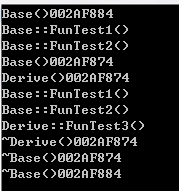C++里的继承和多态(中)——分析单继承、多继承、菱形继承(不含虚函数)
1、单继承
class Base
{
public:
Base()
{
cout << "Base()" << this << endl;
}
void FunTest1()
{
cout << "Base::FunTest1()" << endl;
}
void FunTest2()
{
cout << "Base::FunTest2()" << endl;
}
~Base()
{
cout << "~Base()" << endl;
}
int _data1;
};
class Derive :public Base
{
public:
void FunTest3()
{
cout << "Derive::FunTest3()" << endl;
}
int _data2;
};
int main()
{
Base b;
b.FunTest1();
b.FunTest2();
b._data1 = 0x04;
Derive d;
d.FunTest1();
d.FunTest2();
d.FunTest3();
d._data1 = 0x01;
d._data2 = 0x02;
return 0;
}
——b对象和d对象的对象模型
main 函数的反汇编
派生类的构造函数:
程序运行结果:
构造函数:
基类构造函数:Base( )884 ->派生类构造函数: Base( )874 ->Derive( )874
析构函数:
派生类的析构函数:~Derive( )874 -> ~Base( )874->基类的析构函数:~Base( )884
2、多继承
class Base
{
public:
Base()
{
cout << "Base()" << this << endl;
}
void FunTest1()
{
cout << "Base::FunTest1()" << endl;
}
void FunTest2()
{
cout << "Base::FunTest2()" << endl;
}
~Base()
{
cout << "~Base()" << endl;
}
int _data1;
};
class Base1
{
public:
Base1()
{
cout << "Base1()" << endl;
}
void FunTest3()
{
cout << "Base::FunTest3()" << endl;
}
void FunTest4()
{
cout << "Base::FunTest4()" << endl;
}
int _data3;
};
class Derive :public Base,public Base1
{
public:
Derive()
{
cout << "Derive()" << this << endl;
}
void FunTest5()
{
cout << "Derive:FunTest5()" << endl;
}
~Derive()
{
cout << "~Derive()" << endl;
}
int _data2;
};
int main()
{
Base b;
b.FunTest1();
b.FunTest2();
b._data1 = 0x04;
Base1 b1;
b1.FunTest3();
b1.FunTest4();
b1._data3 = 0x05;
Derive d;
d.FunTest1();
d.FunTest2();
d.FunTest3();
d.FunTest4();
d.FunTest5();
d._data1 = 0x01;
d._data2 = 0x02;
d._data3 = 0x03;
return 0;
}
对象模型:
main函数的反汇编:
派生类的构造函数:
先调用Base的构造函数,再调用Base1的构造函数
析构函数的调用:
先是派生类的析构函数,再试Base1的析构函数,最后是Base的析构函数
在派生类的析构函数中又会调用基类的析构函数:
在派生类的析构函数中,也是先调用Base1的析构函数,再调用Base的析构函数。与构造函数的顺序正好相反
程序运行的结果:
构造函数:
j基类的构造函数:Base( )D9c -> Base1( )D90 -> 派生类中的构造函数:Base( )D7c -> Base1 ( )D80 -> Derive( )D7c
析构函数:
派生类中的析构函数:~Derive( )D7c -> ~Base1( )D80 -> ~Base( )D7c ->基类的析构函数:~Base1( )D90 -> ~Base( )D9C
3、菱形继承
class Base
{
public :
Base()
{
cout << "Base()" << this << endl;
}
void FunTest1()
{
cout << "Base::FunTest1()" << endl;
}
~Base()
{
cout << "~Base()" << endl;
}
};
class Derive : public Base
{
public :
Derive()
{
cout << "Derive()" << this << endl;
}
void FunTest2()
{
cout << "Derive:FunTest2()" << endl;
}
~Derive()
{
cout << "~Derive()" << endl;
}
};
class Derive1 : public Base
{
public :
Derive1()
{
cout << "Derive1()" << this << endl;
}
void FunTest3()
{
cout << "Derive:FunTest4()" << endl;
}
~Derive1()
{
cout << "~Derive1()" << endl;
}
};
class Derive2 : public Derive ,public Derive1
{
public :
Derive2()
{
cout << "Derive2()" << endl;
}
void FunTest4()
{
cout << "Derive:FunTest4()" << endl;
}
};
int main()
{
Base b;
b.FunTest1();
Derive d;
d.FunTest1();
d.FunTest2();
Derive1 d1;
d1.FunTest1();
d1.FunTest3();
Derive2 d2;
//d2.FunTest1();会出现二义性
d2. Derive ::FunTest1();
d2. Derive1 ::FunTest1();
d2.FunTest2();
d2.FunTest3();
d2.FunTest4();
return 0;
}
对象模型:
Derive和Derive1中都含有了Base,会产生二义性和数据冗余。
main函数的反汇编:
派生类的构造函数:
在派生类的构造函数中,都先调用的基类的构造函数。
Derive()
Derive1()
Derive2()
析构函数的调用:
析构函数的顺序和构造函数的顺序正好相反。
~Derive2( )->~Derive1( )->~Derive( )->~Base( ),
派生类中析构函数的调用:
在~Derive2(),先是自己的析构函数,再调用了~Derive1(),再调用了~Derive(),
在~Derive1( )中先是自己的析构函数,又调用了~Base()
在~Derive( )中先是自己的析构函数,又调用了~Base()
程序运行结果:
构造函数:
Base( )B8F ->
Derive的构造函数:Base( )B83 -> Derive( )B83->
Derive1的构造函数:Base( )B77 -> Derive1( )B77->
Derive2的构造函数:Base( )B6B -> Derive( )B6B ->Base( )B6C -> Derive1( )B6C ->Derive2( )B6B
析构函数:
~Derive2( )B6B -> ~Derive1( )B6C ->~Base( )B6C -> ~Derive( )B6B -> ~Base( )B6B
~Derive1( )B77 -> ~Base( )B77 -> ~Derive( )B83 -> ~Base( )B83
~Base( )B8F






















